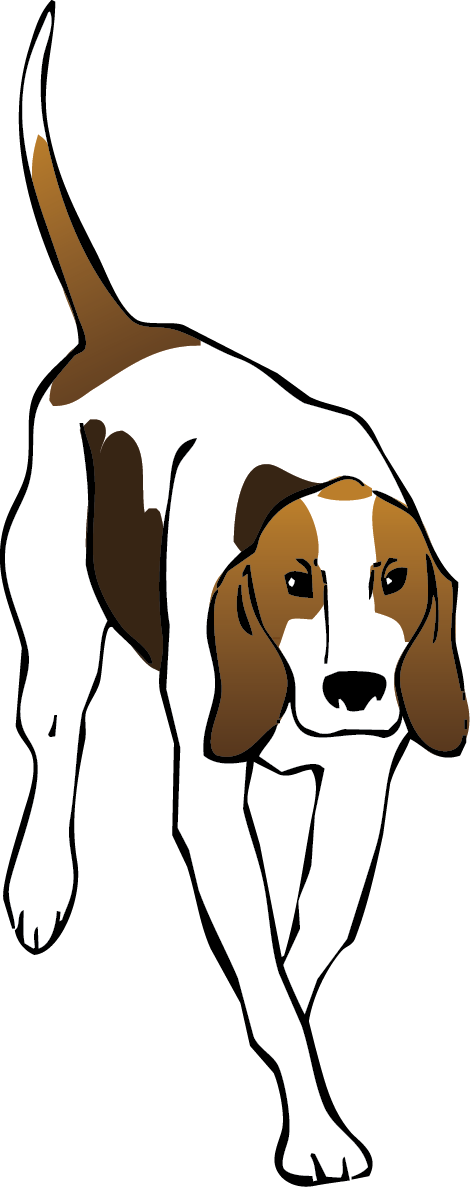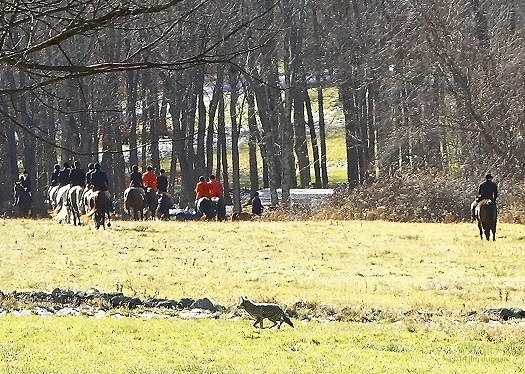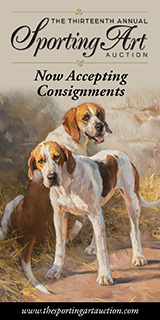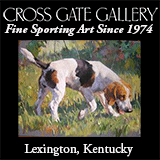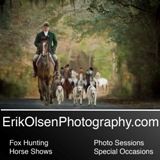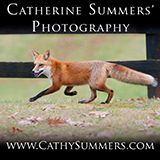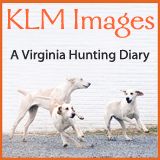coyote
Suspension
Snow on the ground or falling from the sky, no matter. The Golden’s Bridge Hounds (NY) and huntsman Codie Hayes are determined to keep coyotes on the move until the very last day in March. This coyote, writes photographer Jim Duggan, “kept circling as usual at this time of year with the mate and pups located somewhere on this fixture. Otherwise, I’m sure he would have taken the usual straight line away from the field. He got away with a zig and a zag, plus the help of snow falling and winds gusting to thirty-five mph. I sat at my spot overlooking an open field where I have had a few good shots in the past. Immobility and two hours of weather finally go to me, and I went back to the car. Found that my camera’s sun shade fell off, and had to drive back to my spot. Found the shade and then heard the hounds giving voice, coming in my direction. Ran back and got the camera just in time. Sometime you just have a little mazzol (luck), with a little experience.” Posted March 30, 2015
Read More
Moore County, NC: Is the Eastern Coyote a new Subspecies?
Every foxhunter in the eastern U.S. is by now well acquainted with the coyote—the Eastern coyote, that is. The question, according to ThePilot.com in Moore County, North Carolina, is this: is the Eastern coyote a new subspecies, or just the same old coyote formerly seen only in our western states? Dr. Colter Chitwood has been studying the Eastern coyote, its DNA, diets, behavior, and movements on the Fort Bragg Military Reservation, an area covering 251 square miles in North Carolina. Chitwood earned his bachelor’s degree in environmental studies at UNC, Chapel Hill, and his master’s and doctorate degrees in fisheries, wildlife, and conservation biology from N.C. State University. He grew up in North Georgia, hunting, fishing, and tramping through the woods. Dr. Chitwood will deliver a presentation of his findings at a meeting of Save Our Sandhills (SOS) on Thursday, January 29, 2014, at 7:00 p.m. at the Southern Pines Civic Club, located at the corner of Pennsylvania Avenue and Ashe Street. The public is invited, and refreshments will be served. See the complete article in ThePilot.com. Posted January 25, 2015
Read More
The Coyote: Thriving Through Persecution
Dr. Stanley Gehrt and an anesthesized coyote in metropolitan ChicagoThe Belle Meade Hounds in Thomson, Georgia will once again stage their annual Hunt Week—Gone Away with the Wind—this season from January 18 to 24. As before, the week will be fun-filled with hunting, parties, a hunt ball, and the camaraderie of the field.
As a bonus, this year’s affair will feature a fascinating presentation by special guest Dr. Stanley Ghert, Associate Professor of Wildlife Ecology and a Wildlife Extension Specialist at Ohio State University.
Dr. Ghert, who has enthralled foxhunters at MFHA meetings over the years, will talk to Belle Meade Hunt Week attendees on Thursday morning, January 22, about his special subject of research—the coyote. This much-aligned animal has survived and even flourished over the past hundred years despite the best efforts of the federal government to eradicate it.
Early in the twentieth century, at the behest of western ranching and agricultural interests that were losing stock to predators, the U.S. Government instituted program after program designed to erase the wolf, grizzly bear, mountain lion, and coyote from the landscape. The programs were mostly successful in their purpose. The wolf, grizzly, and mountain lion were driven nearly to extinction. The coyote, however, was the one predator that not only survived the pressure, but increased its population and its range, slowly expanding eastward and covering now the entire country. How it did that is one of the mysteries of the animal world.
Behind Enemy Lines
Click photo for larger view Photographer Jim Duggan was perfectly positioned to catch this clever coyote stealthily sneaking behind the field of the Golden’s Bridge Hounds (NY) at Vaile Lane. Posted November 28, 2014
Read More
Consensus at Green Creek: A Barnburner!
Huntsman Tot Goodwin and the Green Creek Hounds / Erik Olsen photo
It’s always fun to hear a day’s hunting described by different members of the hunt. Years ago I would ask Mrs. A how the day had been, and she would assure me, “They ran and screamed all day.” When Mr. B was queried, he said, “They had a bit of a flurry.” When Mr. C was asked the same question, “They didn’t do a thing.” This past Thursday, however, everyone at Green Creek Hounds (Carolinas) agreed it was a barnburner!
Hounds met at Coxe Road where a few of the young entry thought the deer they saw were worth a go. Puppies were reprimanded, and they hacked obediently through the woods to East Green Creek Road. It was a cool, misty morning with great scenting conditions. This is known as coyote country. Tot sent the pack into covert and allowed them to trail for ten or fifteen minutes, and then they opened. All hounds were on (thirty couple), and the cry was ear-splitting.
Coyote Population Rising in North Carolina
Coyote Population Rising in North Carolina Populating just the western part of North Carolina only ten years ago, coyotes are now said to be in all one hundred counties, according to an article by Michael Charbonneau for the Capitol Broadcasting Company. Nor have coyote sightings there been confined to rural areas. This year, seventeen separate sightings occurred near homes in North Raleigh, downtown in the state’s capital of Raleigh, and at Raleigh-Durham airport where two were killed in October by planes on the runway. One farmer who expects to lose at least five calves to coyotes each year recently lost twenty in one week. Coyotes are not protected in North Carolina and may be trapped or shot depending on where they live. Posted November 21, 2013
Read More
A View from the Second Flight at Whiskey Road
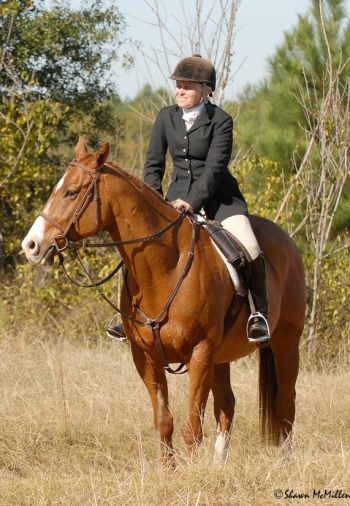 Cornelia Henderson and Banjo / Shawn McMillen photoI was brushing Banjo's mane before a meeting of the Whiskey Road Foxhounds (SC). It was standing on end from static electricity, and I thought, “Oh, rats. It's not going to be a very good day today....too dry.” Was I ever wrong!
Cornelia Henderson and Banjo / Shawn McMillen photoI was brushing Banjo's mane before a meeting of the Whiskey Road Foxhounds (SC). It was standing on end from static electricity, and I thought, “Oh, rats. It's not going to be a very good day today....too dry.” Was I ever wrong!
And John Emery had apparently told Master Lynn Smith that if the hounds spent another day in the swamp, he wasn't EVER going back to the Jackson meet. No worries there; John will definitely be back.
We started out toward Averitt Valley Road with hounds speaking in the woods on the in-country side. They worked hard, and first flight took off down and around Kirkland and in by the chicken houses. Second flight held up a bit and listened and watched, finally deciding to move along behind first. That's when all hell broke loose in the middle of the country with hounds screaming away while we were still on the far edge.
Naturalist’s Notebook: The Coyote
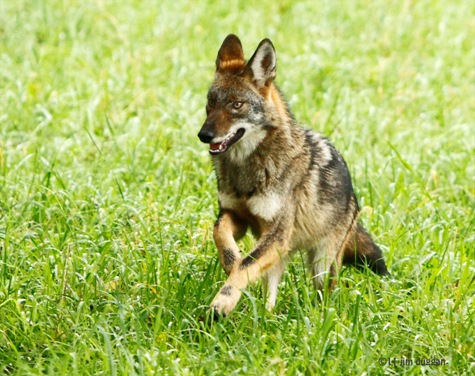 Jim Duggan photoAs a followup to Mark Twain’s rollicking description of the coyote and Susan Walker’s report on the Longreen Foxhound’s recent coyote chase, here’s further information about that secretive animal that provides so many North American hunts with their sport. I’m unable to provide a source reference for this excellent bit of wood lore, but if any reader recognizes it and can identify the source, we will publish that information in a future issue.
Jim Duggan photoAs a followup to Mark Twain’s rollicking description of the coyote and Susan Walker’s report on the Longreen Foxhound’s recent coyote chase, here’s further information about that secretive animal that provides so many North American hunts with their sport. I’m unable to provide a source reference for this excellent bit of wood lore, but if any reader recognizes it and can identify the source, we will publish that information in a future issue.
The coyote, Canis latrans, with its many varieties, known also as brush wolf and prairie wolf, is widespread and well known.
I sometimes think that the most conspicuous coyote sign is his night song. Certainly a camp on the plains in the Southwest or in the western mountains is cozier when enhanced by the serenade of coyote in the moonlight. He who would follow the mammals in the wilds should know something of the significance of this. Unaccustomed ears, trained by traditional journalism, might interpret the coyote voice as something doleful, a sad requiem that makes one crowd closer to the campfire. Or a flippant tongue might speak of the "yapping" of the coyotes.
But if the coyote could reflect and speak he would say this is his song, simply that. However it may appear to human ears, to the coyote it satisfies the universal impulse for expression of emotion, simple as that may sometimes be among furred animals.
The Coyote: An Allegory of “Want”
 Jim Duggan photo
Jim Duggan photo
Here is the funniest, most perceptive and penetrating description of the coyote that I have ever read! Excerpted from Roughing It, a collection of Mark Twain's experiences while prospecting and reporting in the Wild West between 1861 and 1867.
Another night of alternate tranquility and turmoil. But morning came, by and by. It was another glad awakening to fresh breezes, vast expanses of level greensward, bright sunlight, and impressive solitude utterly without human beings or human habitations, and an atmosphere of such amazing properties that trees that seemed close at hand were more than three miles away.
We resumed undress uniform, climbed atop of the flying coach, dangled our legs over the side, shouted occasionally at our frantic mules, merely to see them lay their ears back and scamper faster, tied our hats on to keep our hair from blowing away, and leveled an outlook over the world-wide carpet about us for things new and strange to gaze at. Even at this day it thrills me through and through to think of the life, the gladness, and the wild sense of freedom that used to make the blood dance in my veins on those fine overland mornings!
Along about an hour after breakfast we saw the first prairie-dog villages, the first antelope, and the first wolf. If I remember rightly, this latter was the regular coyote (pronounced ky-o-te) of the farther deserts. And if it was, he was not a pretty creature or respectable either, for I got well acquainted with his race afterward, and can speak with confidence.
The Coyote, An “Allegory of Want”
Here is the funniest, most perceptive, and penetrating description of the coyote that I have ever read! Excerpted from "Roughing It," a collection of Mark Twain's experiences while traveling through the Wild West by mule wagon between 1861 and 1867. From the Foxhunting Life archives.
 Jim Duggan photo
Jim Duggan photo
Another night of alternate tranquility and turmoil. But morning came, by and by. It was another glad awakening to fresh breezes, vast expanses of level greensward, bright sunlight, and impressive solitude utterly without human beings or human habitations, and an atmosphere of such amazing properties that trees that seemed close at hand were more than three miles away.
We resumed undress uniform, climbed atop of the flying coach, dangled our legs over the side, shouted occasionally at our frantic mules, merely to see them lay their ears back and scamper faster, tied our hats on to keep our hair from blowing away, and leveled an outlook over the world-wide carpet about us for things new and strange to gaze at. Even at this day it thrills me through and through to think of the life, the gladness, and the wild sense of freedom that used to make the blood dance in my veins on those fine overland mornings!
Along about an hour after breakfast we saw the first prairie-dog villages, the first antelope, and the first wolf. If I remember rightly, this latter was the regular coyote (pronounced ky-o-te) of the farther deserts. And if it was, he was not a pretty creature or respectable either, for I got well acquainted with his race afterward, and can speak with confidence.
